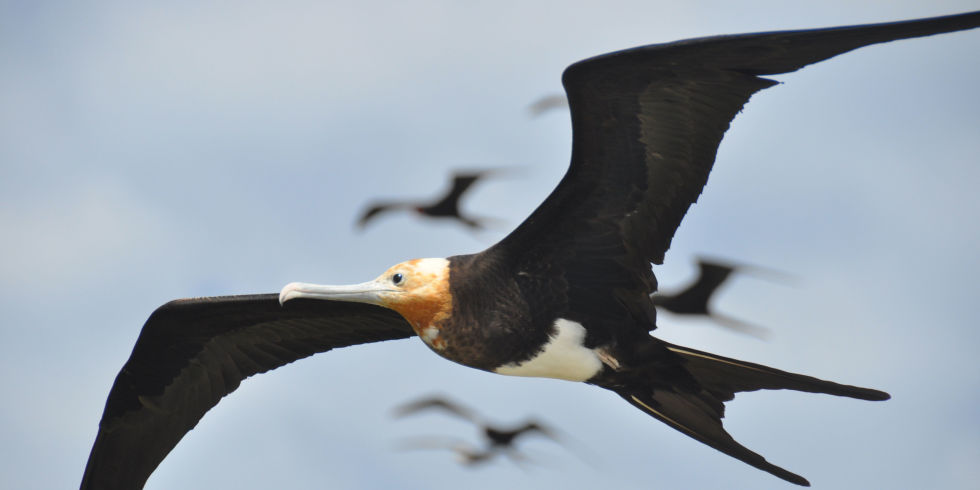How This Bird Stays in Flight for What Feels Like Forever
The great frigate can stay aloft for 56 days by riding natural updrafts.
Plenty of birds fly vast distances on their migratory trips around planet Earth. But the most amazing of all might be the frigate bird, which can stay aloft for two months straight without landing or resting. How the heck do they do that?
A team of biologists led by Henri Weimerskirch at the French National Center for Scientific Research just announced the results of a major new study on great frigates (Fregata minor), these fascinating seabirds native to the central Indian and Pacific Oceans. Using super-lightweight GPS trackers, the biologists followed four dozen birds from 2011 to 2015, some for up to two years continuously. What they found was astonishing. The birds could stay aloft for up to 56 days without landing, gliding for hundreds of miles per day with wing-flaps just every 6 minutes, and reaching altitude of more than 2.5 miles.
Before this new research, “it was known that frigate birds could stay several days aloft,” says Weimerskirch, “but that they can stay two months [continuously in the air] is completely unexpected.” The biologists’ description of the bird’s fantastical flights are published today in the journal Science.
The scientists attached those lightweight satellite transmitters to the nape of the birds’ necks. The tiny solar-powered trackers included GPS, heart rate monitors, accelerometers, and altimeters. They weighed only 10 grams, which made it possible to track the birds without affecting their flight, says Weimerskirch.
Scientists had known that the remarkable frigate birds had the lowest wing load of all birds, meaning the least amount of body weight distributed over the total area of their wings. Although they are seabirds, great frigates do not have water-repellent feathers, so they can’t land and stay afloat on water. It wasn’t until today that biologists have fully comprehended the fascinating strategy behind the birds’ long ocean flights.
It turns out that great frigates soar and glide in long, roller-coaster swoops by taking advantage of the unique weather patterns in the middle of the Indian ocean. Instead of constantly flapping, the birds siphon off atmospheric energy to fly—they tack in updrafts to rocket into the air.

Throughout the year, huge swaths of the Indian Ocean will remain relatively windless. There are the doldrums. Great frigates will stick to the edges of these doldrums, circling them over days and months. They do so because the weather patterns found at the edges are relatively constant—and therefore reliable—and sprinkled with puffy, low-laying cumulus clouds. Beneath these cotton-looking clouds tend to be updrafts the birds can ride.
When flying around these doldrums, the birds will spend only around 10 percent of their time looking for food. The rest of time the birds soar from cumulus cloud to cumulus cloud, traveling up to 400 miles per day. The birds can fly without landing or resting for months, and it’s thought that they might somehow be sleeping in the air during these long travels. Weimerskirch team found that sometimes a soaring bird’s resting heart rate was as low as when they were simply sitting on their nests, meaning that flying was close to effortless.
Before this study, scientists were pretty sure that while great frigates might use clouds for their updrafts, they probably avoided actually entering them, because of the potential for chaotic turbulence. We now know this is wrong.
“Our study shows that they do it intentionally,” says Weimerskirch. When the distance between two clouds is vast, great frigates will enter the clouds and use the its odd dynamics to shoot far higher into the air than normal so they can glide a greater distance. The scientists saw that some birds could fly as high as 2.5 miles in the air, where the oxygen is unbearably thin and water freezes into ice. All told, the birds tend to favor lower distances—from 150 to 2,000 feet above the lapping ocean waves.






























